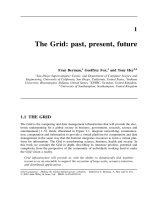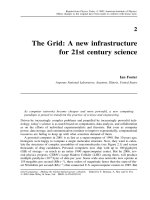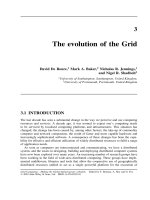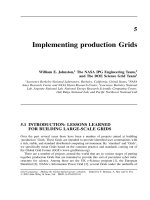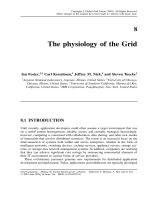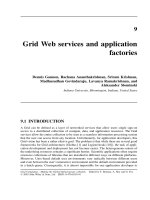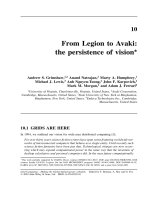Grid Computing P1
Bạn đang xem bản rút gọn của tài liệu. Xem và tải ngay bản đầy đủ của tài liệu tại đây (1.69 MB, 42 trang )
1
The Grid: past, present, future
Fran Berman,
1
Geoffrey Fox,
2
and Tony Hey
3,4
1
San Diego Supercomputer Center, and Department of Computer Science and
Engineering, University of California, San Diego, California, United States,
2
Indiana
University, Bloomington, Indiana, United States,
3
EPSRC, Swindon, United Kingdom,
4
University of Southampton, Southampton, United Kingdom
1.1 THE GRID
The Grid is the computing and data management infrastructure that will provide the elec-
tronic underpinning for a global society in business, government, research, science and
entertainment [1–5]. Grids, illustrated in Figure 1.1, integrate networking, communica-
tion, computation and information to provide a virtual platform for computation and data
management in the same way that the Internet integrates resources to form a virtual plat-
form for information. The Grid is transforming science, business, health and society. In
this book we consider the Grid in depth, describing its immense promise, potential and
complexity from the perspective of the community of individuals working hard to make
the Grid vision a reality.
Grid infrastructure will provide us with the ability to dynamically link together
resources as an ensemble to support the execution of large-scale, resource-intensive,
and distributed applications.
Grid Computing – Making the Global Infrastructure a Reality. Edited by F. Berman, A. Hey and G. Fox
2003 John Wiley & Sons, Ltd ISBN: 0-470-85319-0
10
FRAN BERMAN, GEOFFREY FOX, AND TONY HEY
Imaging instruments
Computational
resources
Large-scale databases
Data
acquisition
Analysis
Advanced
visualization
Figure 1.1 Grid resources linked together for neuroscientist Mark Ellisman’s Telescience appli-
cation ( />Large-scale Grids are intrinsically distributed, heterogeneous and dynamic. They pro-
mise effectively infinite cycles and storage, as well as access to instruments, visualization
devices and so on without regard to geographic location. Figure 1.2 shows a typical early
successful application with information pipelined through distributed systems [6]. The
reality is that to achieve this promise, complex systems of software and services must
be developed, which allow access in a user-friendly way, which allow resources to be
used together efficiently, and which enforce policies that allow communities of users to
coordinate resources in a stable, performance-promoting fashion. Whether users access the
Grid to use one resource (a single computer, data archive, etc.), or to use several resources
in aggregate as a coordinated ‘virtual computer’, the Grid permits users to interface with
the resources in a uniform way, providing a comprehensive and powerful platform for
global computing and data management.
In the United Kingdom this vision of increasingly global collaborations for scientific
research is encompassed by the term e-Science [7]. The UK e-Science Program is a
major initiative developed to promote scientific and data-oriented Grid application devel-
opment for both science and industry. The goals of the e-Science initiative are to assist in
global efforts to develop a Grid e-Utility infrastructure for e-Science applications, which
will support in silico experimentation with huge data collections, and assist the develop-
ment of an integrated campus infrastructure for all scientific and engineering disciplines.
e-Science merges a decade of simulation and compute-intensive application development
with the immense focus on data required for the next level of advances in many scien-
tific disciplines. The UK program includes a wide variety of projects including health
and medicine, genomics and bioscience, particle physics and astronomy, environmental
science, engineering design, chemistry and material science and social sciences. Most
e-Science projects involve both academic and industry participation [7].
THE GRID: PAST, PRESENT, FUTURE
11
Box 1.1 Summary of Chapter 1
This chapter is designed to give a high-level motivation for the book. In Section 1.2,
we highlight some historical and motivational building blocks of the Grid – described
in more detail in Chapter 3. Section 1.3 describes the current community view of
the Grid with its basic architecture. Section 1.4 contains four building blocks of
the Grid. In particular, in Section 1.4.1 we review the evolution of the network-
ing infrastructure including both the desktop and cross-continental links, which
are expected to reach gigabit and terabit performance, respectively, over the next
five years. Section 1.4.2 presents the corresponding computing backdrop with 1
to 40 teraflop performance today moving to petascale systems by the end of the
decade. The U.S. National Science Foundation (NSF) TeraGrid project illustrates
the state-of-the-art of current Grid technology. Section 1.4.3 summarizes many of
the regional, national and international activities designing and deploying Grids.
Standards, covered in Section 1.4.4 are a different but equally critical building block
of the Grid. Section 1.5 covers the critical area of applications on the Grid covering
life sciences, engineering and the physical sciences. We highlight new approaches
to science including the importance of collaboration and the e-Science [7] concept
driven partly by increased data. A short section on commercial applications includes
the e-Enterprise/Utility [10] concept of computing power on demand. Applications
are summarized in Section 1.5.7, which discusses the characteristic features of ‘good
Grid’ applications like those illustrated in Figures 1.1 and 1.2. These show instru-
ments linked to computing, data archiving and visualization facilities in a local Grid.
Part D and Chapter 35 of the book describe these applications in more detail. Futures
are covered in Section 1.6 with the intriguing concept of autonomic computing devel-
oped originally by IBM [10] covered in Section 1.6.1 and Chapter 13. Section 1.6.2
is a brief discussion of Grid programming covered in depth in Chapter 20 and Part C
of the book. There are concluding remarks in Sections 1.6.3 to 1.6.5.
General references can be found in [1–3] and of course the chapters of this
book [4] and its associated Web site [5]. The reader’s guide to the book is given in
the preceding preface. Further, Chapters 20 and 35 are guides to Parts C and D of the
book while the later insert in this chapter (Box 1.2) has comments on Parts A and B
of this book. Parts of this overview are based on presentations by Berman [11]
and Hey, conferences [2, 12] and a collection of presentations from the Indiana
University on networking [13–15].
In the next few years, the Grid will provide the fundamental infrastructure not only
for e-Science but also for e-Business, e-Government, e-Science and e-Life. This emerging
infrastructure will exploit the revolutions driven by Moore’s law [8] for CPU’s, disks and
instruments as well as Gilder’s law [9] for (optical) networks. In the remainder of this
chapter, we provide an overview of this immensely important and exciting area and a
backdrop for the more detailed chapters in the remainder of this book.
12
FRAN BERMAN, GEOFFREY FOX, AND TONY HEY
Tomographic
reconstruction
Real-time
collection
Wide-area
dissemination
Desktop & VR clients
with shared controls
Advanced photon source
Archival
storage
/>Figure 1.2 Computational environment for analyzing real-time data taken at Argonne’s advanced
photon source was an early example of a data-intensive Grid application [6]. The picture shows data
source at APS, network, computation, data archiving, and visualization. This figure was derived
from work reported in “Real-Time Analysis, Visualization, and Steering of Microtomography Exper-
iments at Photon Sources”, Gregor von Laszewski, Mei-Hui Su, Joseph A. Insley, Ian Foster, John
Bresnahan, Carl Kesselman, Marcus Thiebaux, Mark L. Rivers, Steve Wang, Brian Tieman, Ian
McNulty, Ninth SIAM Conference on Parallel Processing for Scientific Computing, Apr. 1999.
1.2 BEGINNINGS OF THE GRID
It is instructive to start by understanding the influences that came together to ultimately
influence the development of the Grid. Perhaps the best place to start is in the 1980s, a
decade of intense research, development and deployment of hardware, software and appli-
cations for parallel computers. Parallel computing in the 1980s focused researchers’ efforts
on the development of algorithms, programs and architectures that supported simultaneity.
As application developers began to develop large-scale codes that pushed against the
resource limits of even the fastest parallel computers, some groups began looking at dis-
tribution beyond the boundaries of the machine as a way of achieving results for problems
of larger and larger size.
During the 1980s and 1990s, software for parallel computers focused on providing
powerful mechanisms for managing communication between processors, and develop-
ment and execution environments for parallel machines. Parallel Virtual Machine (PVM),
Message Passing Interface (MPI), High Performance Fortran (HPF), and OpenMP were
developed to support communication for scalable applications [16]. Successful application
paradigms were developed to leverage the immense potential of shared and distributed
memory architectures. Initially it was thought that the Grid would be most useful in
extending parallel computing paradigms from tightly coupled clusters to geographically
distributed systems. However, in practice, the Grid has been utilized more as a platform
for the integration of loosely coupled applications – some components of which might be
THE GRID: PAST, PRESENT, FUTURE
13
running in parallel on a low-latency parallel machine – and for linking disparate resources
(storage, computation, visualization, instruments). The fundamental Grid task of manag-
ing these heterogeneous components as we scale the size of distributed systems replaces
that of the tight synchronization of the typically identical [in program but not data as in
the SPMD (single program multiple data) model] parts of a domain-decomposed parallel
application.
During the 1980s, researchers from multiple disciplines also began to come together to
attack ‘Grand Challenge’ problems [17], that is, key problems in science and engineering
for which large-scale computational infrastructure provided a fundamental tool to achieve
new scientific discoveries. The Grand Challenge and multidisciplinary problem teams
provided a model for collaboration that has had a tremendous impact on the way large-
scale science is conducted to date. Today, interdisciplinary research has not only provided
a model for collaboration but has also inspired whole disciplines (e.g. bioinformatics) that
integrate formerly disparate areas of science.
The problems inherent in conducting multidisciplinary and often geographically dis-
persed collaborations provided researchers experience both with coordination and dis-
tribution – two fundamental concepts in Grid Computing. In the 1990s, the US Gigabit
testbed program [18] included a focus on distributed metropolitan-area and wide-area
applications. Each of the test beds – Aurora, Blanca, Casa, Nectar and Vistanet – was
designed with dual goals: to investigate potential testbed network architectures and to
explore their usefulness to end users. In this second goal, each testbed provided a venue
for experimenting with distributed applications.
The first modern Grid is generally considered to be the information wide-area year (I-
WAY), developed as an experimental demonstration project for SC95. In 1995, during the
week-long Supercomputing conference, pioneering researchers came together to aggregate
a national distributed testbed with over 17 sites networked together by the vBNS. Over 60
applications were developed for the conference and deployed on the I-WAY, as well as a
rudimentary Grid software infrastructure (Chapter 4) to provide access, enforce security,
coordinate resources and other activities. Developing infrastructure and applications for
the I-WAY provided a seminal and powerful experience for the first generation of modern
Grid researchers and projects. This was important as the development of Grid research
requires a very different focus than distributed computing research. Whereas distributed
computing research generally focuses on addressing the problems of geographical sepa-
ration, Grid research focuses on addressing the problems of integration and management
of software.
I-WAY opened the door for considerable activity in the development of Grid soft-
ware. The Globus [3] (Chapters 6 and 8) and Legion [19–21] (Chapter 10) infrastructure
projects explored approaches for providing basic system-level Grid infrastructure. The
Condor project [22] (Chapter 11) experimented with high-throughput scheduling, while
the AppLeS [23], APST (Chapter 33), Mars [24] and Prophet [25] projects experimented
with high-performance scheduling. The Network Weather Service [26] project focused on
resource monitoring and prediction, while the Storage Resource Broker (SRB) [27] (Chap-
ter 16) focused on uniform access to heterogeneous data resources. The NetSolve [28]
(Chapter 24) and Ninf [29] (Chapter 25) projects focused on remote computation via a
14
FRAN BERMAN, GEOFFREY FOX, AND TONY HEY
client-server model. These, and many other projects, provided a foundation for today’s
Grid software and ideas.
In the late 1990s, Grid researchers came together in the Grid Forum, subsequently
expanding to the Global Grid Forum (GGF) [2], where much of the early research is now
evolving into the standards base for future Grids. Recently, the GGF has been instrumental
in the development of the Open Grid Services Architecture (OGSA), which integrates
Globus and Web services approaches (Chapters 7, 8, and 9). OGSA is being developed
by both the United States and European initiatives aiming to define core services for a
wide variety of areas including:
•
Systems Management and Automation
•
Workload/Performance Management
•
Security
•
Availability/Service Management
•
Logical Resource Management
•
Clustering Services
•
Connectivity Management
•
Physical Resource Management.
Today, the Grid has gone global, with many worldwide collaborations between the
United States, European and Asia-Pacific researchers. Funding agencies, commercial ven-
dors, academic researchers, and national centers and laboratories have come together to
form a community of broad expertise with enormous commitment to building the Grid.
Moreover, research in the related areas of networking, digital libraries, peer-to-peer com-
puting, collaboratories and so on are providing additional ideas relevant to the Grid.
Although we tend to think of the Grid as a result of the influences of the last 20 years,
some of the earliest roots of the Grid can be traced back to J.C.R. Licklider, many years
before this. ‘Lick’ was one of the early computing and networking pioneers, who set the
scene for the creation of the ARPANET, the precursor to today’s Internet. Originally an
experimental psychologist at MIT working on psychoacoustics, he was concerned with
the amount of data he had to work with and the amount of time he required to organize
and analyze his data. He developed a vision of networked computer systems that would
be able to provide fast, automated support systems for human decision making [30]:
‘If such a network as I envisage nebulously could be brought into operation, we could
have at least four large computers, perhaps six or eight small computers, and a great
assortment of disc files and magnetic tape units – not to mention remote consoles and
teletype stations – all churning away’
In the early 1960s, computers were expensive and people were cheap. Today, after
thirty odd years of Moore’s Law [8], the situation is reversed and individual laptops
now have more power than Licklider could ever have imagined possible. Nonetheless,
his insight that the deluge of scientific data would require the harnessing of computing
resources distributed around the galaxy was correct. Thanks to the advances in networking
and software technologies, we are now working to implement this vision.
THE GRID: PAST, PRESENT, FUTURE
15
In the next sections, we provide an overview of the present Grid Computing and its
emerging vision for the future.
1.3 A COMMUNITY GRID MODEL
Over the last decade, the Grid community has begun to converge on a layered model that
allows development of the complex system of services and software required to integrate
Grid resources. This model, explored in detail in Part B of this book, provides a layered
abstraction of the Grid. Figure 1.3 illustrates the Community Grid Model being developed
in a loosely coordinated manner throughout academia and the commercial sector. We begin
discussion by understanding each of the layers in the model.
The bottom horizontal layer of the Community Grid Model consists of the hard-
ware resources that underlie the Grid. Such resources include computers, networks, data
archives, instruments, visualization devices and so on. They are distributed, heteroge-
neous and have very different performance profiles (contrast performance as measured in
FLOPS or memory bandwidth with performance as measured in bytes and data access
time). Moreover, the resource pool represented by this layer is highly dynamic, both as
a result of new resources being added to the mix and old resources being retired, and
as a result of varying observable performance of the resources in the shared, multiuser
environment of the Grid.
The next horizontal layer (common infrastructure) consists of the software services and
systems which virtualize the Grid. Community efforts such as NSF’s Middleware Initiative
(NMI) [31], OGSA (Chapters 7 and 8), as well as emerging de facto standards such as
Globus provide a commonly agreed upon layer in which the Grid’s heterogeneous and
dynamic resource pool can be accessed. The key concept at the common infrastructure
layer is community agreement on software, which will represent the Grid as a unified
virtual platform and provide the target for more focused software and applications.
The next horizontal layer (user and application-focused Grid middleware, tools and
services) contains software packages built atop the common infrastructure. This software
serves to enable applications to more productively use Grid resources by masking some
of the complexity involved in system activities such as authentication, file transfer, and
Common infrastructure layer
(NMI, GGF standards, OGSA etc.)
Global resources
User-focused grid middleware,
tools and services
Grid applications
Common
policies
Grid
economy
Global-
area
networking
New
devices
Sensors
Wireless
Figure 1.3 Layered architecture of the Community Grid Model.
16
FRAN BERMAN, GEOFFREY FOX, AND TONY HEY
so on. Portals, community codes, application scheduling software and so on reside in this
layer and provide middleware that connects applications and users with the common Grid
infrastructure.
The topmost horizontal layer (Grid applications) represents applications and users.
The Grid will ultimately be only as successful as its user community and all of the
other horizontal layers must ensure that the Grid presents a robust, stable, usable and
useful computational and data management platform to the user. Note that in the broadest
sense, even applications that use only a single resource on the Grid are Grid applications
if they access the target resource through the uniform interfaces provided by the Grid
infrastructure.
The vertical layers represent the next steps for the development of the Grid. The verti-
cal layer on the left represents the influence of new devices – sensors, PDAs, and wireless.
Over the next 10 years, these and other new devices will need to be integrated with the
Grid and will exacerbate the challenges of managing heterogeneity and promoting per-
formance. At the same time, the increasing globalization of the Grid will require serious
consideration of policies for sharing and using resources, global-area networking and the
development of Grid economies (the vertical layer on the right – see Chapter 32). As
we link together national Grids to form a Global Grid, it will be increasingly important
to develop Grid social and economic policies which ensure the stability of the system,
promote the performance of the users and successfully integrate disparate political, tech-
nological and application cultures.
The Community Grid Model provides an abstraction of the large-scale and intense
efforts of a community of Grid professionals, academics and industrial partners to build
the Grid. In the next section, we consider the lowest horizontal layers (individual resources
and common infrastructure) of the Community Grid Model.
1.4 BUILDING BLOCKS OF THE GRID
1.4.1 Networks
The heart of any Grid is its network – networks link together geographically distributed
resources and allow them to be used collectively to support execution of a single appli-
cation. If the networks provide ‘big pipes’, successful applications can use distributed
resources in a more integrated and data-intensive fashion; if the networks provide ‘small
pipes’, successful applications are likely to exhibit minimal communication and data
transfer between program components and/or be able to tolerate high latency.
At present, Grids build on ubiquitous high-performance networks [13, 14] typified by
the Internet2 Abilene network [15] in the United States shown in Figures 1.4 and 1.5.
In 2002, such national networks exhibit roughly 10 Gb s
−1
backbone performance. Anal-
ogous efforts can be seen in the UK SuperJanet [40] backbone of Figure 1.6 and the
intra-Europe GEANT network [41] of Figure 1.7. More globally, Grid efforts can lever-
age international networks that have been deployed (illustrated in Figure 1.8) including
CA*net3 from Canarie in Canada [42] and the Asian network APAN [43], (shown in detail
in Figure 1.9). Such national network backbone performance is typically complemented by
THE GRID: PAST, PRESENT, FUTURE
17
Abilene Core Node
Abilene Connector
Exchange Point
Abilene Participant
Peer Network
Multihomed Connector
or Participant
OC-3c
OC-12c
OC-48c
OC-192c
GigE
10GigE
IEEAF OC-12c
IEEAF OC-192c
Sunnyvale
Los Angeles
Seattle
Denver
Kansas City
Houston
Atlanta
Indianapolis
New York
Washington
Chicago
SDSC
UC San Diego
UC Irvine
Caltech
Jet Propulsion Lab
USC
UC Riverside
UC Los Angeles
UC Santa Barbara
San Diego State
Cal Poly Pomona
Cal State-
San Bernardino
Nevada-Reno
Desert Research Inst
UNLV
UNINET
CUDI
CALREN-2
DARPA
SuperNet
Arizona St. U
Arizona
UC San Francisco
UC Office of
the President
UC Santa Cruz
UC Davis
Cal State-Hayward
CALREN-2
UC Berkeley
Hawaii
DREN
NISN
NREN
NGIX-AMES
Oregon Health &
Science U
Portland State*
BYU
Oregon State
OREGON*
Stanford
ESnet
Singaren
WIDE
SINET
GEMnet
AARnet
Alaska
NOAA-PMEL
Microsoft
Research
Washington
State
PACIFIC/
NORTHWEST
DREN
APAN/TransPAC
CAnet 4
TANet-2
Pacific Wave
Montana State
Montana
Idaho
US Dept
Commerce
Colorado-Boulder
Colorado-Denver
Wyoming
NCAR
Arkansas
Arkansas
-Little Rock
Washington
CAnet 3
Singaren
RNP2
KOREN/KREONET2
GEMnet
TANet-2
N. Dakota State
South Dakota
DREN
ESnet
NISN
NREN
SURFNet
MAN LAN
SURFNet
CAnet4
CERN
vBNS
NGIX
NORDUnet
STARTAP
MREN
Wisconsin
-Madison
Wisconsin
-Milwaukee
Illinois-Chicago
Argonne
Chicago
Northwestern
Illinois-Urbana
Northern Lights
West Virginia
Penn State
Carnegie Mellon
Pittsburgh
IBM-TJ
Watson
Cornell
Buffalo (SUNY)
Binghamton (SUNY)
Albany (SUNY)
Syracuse
Rochester
Columbia
NYU
Stony Brook
RIT
Michigan State
Michigan
Wayne State
Michigan Tech
Western Michigan
UCAID
MERIT*
Southern Illinois
Notre Dame
Iowa*
Bradley
Motorola Labs
WPI
UCAID
NorduNet
ESnet
Rensselaer
Yale
Vermont
Maine
New Hampshire
Northeastern
Dartmouth
Boston U
Harvard
Tufts
MIT
Connecticut
Rhode Island
EBSCO
U Mass Amherst
Brandeis
Brown
NYSERNet*
CAnet3
HEAnet
GEANT
GTRN
PSC
Drexel
Lehigh
Penn
MAGPI
OARnet
Case Western
Cincinnati
Bowling Green
Akron
Kent State
Ohio State
Ohio U
Wright State
Rutgers
Advanced Network
& Services
Delaware
NCNI
Virginia Tech
George Mason
Old Dominion
William & Mary
VCU
Virginia
NWVng
NOX
UCAID
MAX
Georgia
Georgia Tech
Georgia State
Emory
Kentucky
Clemson
South Carolina
Medical Univ.
of S. Carolina
Tennessee
Alabama
-Huntsville
Alabama
-Tuscaloosa
SOX
Vanderbilt
NGIX
Florida
vBNS
NISN
DREN
A M PAT H
UMD
George
Washington
NSF
Georgetown
Howard Hughes
Medical Ctr
NIH/NLM
EOSDIS/GFSC
NOAA
UMBC
UMB
Catholic
Fujitsu Lab
Gallaudet
Alabama
-Birmingham
Aubur n
REUNA
RNP2
RETINA
ANSP
Florida
Atlantic
Miami
Florida
International
South Florida
Florida A&M
Louisiana State
LAnet
SFGP
Puerto Rico
TEXAS
Rice
Houston
Baylor College
of Med
Texas A&M
SF Austin State
NORTH TEXAS
Texas Tech
CUDI
UT-El Paso
NOAO/AURA
UT-Arlington
UT-Dallas
TCU
North Texas
Southwest Research
Institute
SMU
UT-Austin
UT-SW Med Ctr.
Qwest lab
Oklahoma
Oklahoma State
Tulsa
Toledo
Memphis
OneNet
Jackson State
Mississippi
Southern
Mississippi
Florida State
New Mexico
New Mexico State
Purdue
Washington
Eli Lilly
Indiana
Colorado State
Front Range
Idaho State
Utah State
Utah
Kansas
Kansas State
U Nebraska-Lincoln
Wichita State
Arkansas
Med. Science
Missouri-Rolla
Missouri-Columbia
Missouri-St. Louis
Missouri-KC
Great Plains
WiscREN
NCSA
Iowa State*
Louisville
Tulane
Mississippi
State
ESnet
STARLIGHT
SD School
of Mines
S. Dakota State
EROS Data
Center
North Dakota
Minnesota
Wake Forest
UNC-Chapel Hill
Duke
NC State
East Carolina
Princeton
Children's Hospital
of Philadelphia
J&J
HP Labs
J&J
J&J
Cal Poly,
San Luis Obispo
Central Florida
Portland State*
APAN/TransPAC
upgrade in progress
October 2002
Figure 1.4
Sites on the Abilene Research Network.
18
FRAN BERMAN, GEOFFREY FOX, AND TONY HEY
Abilene Network Backbone
Core Node
OC-48c
OC-192c
Figure 1.5 Backbone of Abilene Internet2 Network in USA.
NNW
Northern
Ireland
MidMAN
TVN
EMMANM
YHMAN
NorMAN
20 Gbps
10 Gbps
2.5 Gbps
622 Mbps
155 Mbps
EastNet
External
links
LMN
Kentish
MAN
LeNSE
SuperJanet4, July2002
SWAN&
BWEMAN
South Wales
MAN
WorldCom
Bristol
WorldCom
Reading
WorldCom
Manchester
WorldCom
Glasgow
WorldCom
Edinburgh
WorldCom
Leeds
WorldCom
London
WorldCom
Portsmouth
Scotland via
Edinburgh
Scotland via
Glasgow
Figure 1.6 United Kingdom National Backbone Research and Education Network.
THE GRID: PAST, PRESENT, FUTURE
19
IS
NO
FI
SE
DK
IE
UK
FR CH
DE
CZ
AT
SI HU
SK
PL
RO
HR
MT
GR
CY
IL
10 Gb s
−1
2.5Gb s
−1
622 Mb s
−1
34−155 Mb s
−1
ESPT IT
NL
BE
LU
EE
LV
LT
Austria
Belgium
Switzerland
Cyprus
Czech Republic
Germany
Denmark
Estonia
Spain
Finland*
France
Greece
Croatia
Hungary
Ireland
Israel
Iceland*
Italy
Lithuania
Luxembourg
Latvia
Malta†
Netherlands
Norway*
Poland
Portugal
Romania
Sweden*
Slovenia
Slovakia
United Kingdom
† Planned connection* Connections between these countries are part of NORDUnet (the Nordic
regional network)
AT
BE
CH
CY
CZ
DE
DK
EE
ES
FI
FR
GR
HR
HU
IE
IL
IS
IT
LT
LU
LV
MT
NL
NO
PL
PT
RO
SE
SI
SK
UK
Figure 1.7 European Backbone Research Network GEANT showing countries and backbone
speeds.
20
FRAN BERMAN, GEOFFREY FOX, AND TONY HEY
Figure 1.8 International Networks.
Figure 1.9 APAN Asian Network.
THE GRID: PAST, PRESENT, FUTURE
21
a1Gbs
−1
institution-to-backbone link and by a 10 to 100 Mb s
−1
desktop-to-institutional
network link.
Although there are exceptions, one can capture a typical leading Grid research envi-
ronment as a 10 : 1 : 0.1 Gbs
−1
ratio representing national: organization: desktop links.
Today, new national networks are beginning to change this ratio. The GTRN or Global
Terabit Research Network initiative shown in Figures 1.10 and 1.11 link national net-
works in Asia, the Americas and Europe with a performance similar to that of their
backbones [44]. By 2006, GTRN aims at a 1000 : 1000 : 100 : 10 : 1 gigabit performance
ratio representing international backbone: national: organization: optical desktop: Copper
desktop links. This implies a performance increase of over a factor of 2 per year in net-
work performance, and clearly surpasses expected CPU performance and memory size
increases of Moore’s law [8] (with a prediction of a factor of two in chip density improve-
ment every 18 months). This continued difference between network and CPU performance
growth will continue to enhance the capability of distributed systems and lessen the gap
between Grids and geographically centralized approaches. We should note that although
network bandwidth will improve, we do not expect latencies to improve significantly. Fur-
ther, as seen in the telecommunications industry in 2000–2002, in many ways network
performance is increasing ‘faster than demand’ even though organizational issues lead to
problems. A critical area of future work is network quality of service and here progress is
less clear. Networking performance can be taken into account at the application level as in
AppLeS and APST ([23] and Chapter 33), or by using the Network Weather Service [26]
and NaradaBrokering (Chapter 22).
Figure 1.10 Logical GTRN Global Terabit Research Network.
22
FRAN BERMAN, GEOFFREY FOX, AND TONY HEY
Figure 1.11
Physical GTRN Global Terabit Research Network.
THE GRID: PAST, PRESENT, FUTURE
23
High-capacity networking increases the capability of the Grid to support both paral-
lel and distributed applications. In the future, wired networks will be further enhanced
by continued improvement in wireless connectivity [45], which will drive integration of
smaller and smaller devices into the Grid. The desktop connectivity described above will
include the pervasive PDA (Personal Digital Assistant included in universal access dis-
cussion of Chapter 18) that will further promote the Grid as a platform for e-Science,
e-Commerce and e-Education (Chapter 43).
1.4.2 Computational ‘nodes’ on the Grid
Networks connect resources on the Grid, the most prevalent of which are computers
with their associated data storage. Although the computational resources can be of any
level of power and capability, some of the most interesting Grids for scientists involve
nodes that are themselves high-performance parallel machines or clusters. Such high-
performance Grid ‘nodes’ provide major resources for simulation, analysis, data mining
and other compute-intensive activities. The performance of the most high-performance
nodes on the Grid is tracked by the Top500 site [46] (Figure 1.12). Extrapolations of
this information indicate that we can expect a peak single machine performance of 1
petaflops/sec (10
15
operations per second) by around 2010.
Contrast this prediction of power to the present situation for high-performance comput-
ing. In March 2002, Japan’s announcement of the NEC Earth Simulator machine shown
in Figure 1.13 [47], which reaches 40 teraflops s
−1
with a good sustained to peak per-
formance rating, garnered worldwide interest. The NEC machine has 640 eight-processor
nodes and offers 10 terabytes of memory and 700 terabytes of disk space. It has already
been used for large-scale climate modeling. The race continues with Fujitsu announcing
ASCl Purple
Earth Simulator
Jun-93
Jun-94
Jun-95
Jun-96
Jun-97
Jun-98
Jun-99
Jun-00
Jun-01
Jun-02
Jun-03
Jun-04
Jun-05
Jun-06
Jun-07
Jun-08
Jun-09
Jun-10
Performance extrapolation
100 MFlop s
−1
1 GFlop s
−1
10 GFlop s
−1
100 GFlop s
−1
1 TFlop s
−1
10 TFlop s
−1
Sum
N = 1
N = 500
100 TFlop s
−1
1 PFlop s
−1
10 PFlop s
−1
TOP500
Figure 1.12 Top 500 performance extrapolated from 1993 to 2010.
24
FRAN BERMAN, GEOFFREY FOX, AND TONY HEY
Processor Node (PIN)
cabinate (320)
Disks
Air conditioning
system
Power supply
systems
Interconnection Network (IN)
cabinets (65)
Cartridge tape library system
Double floor for cables
Figure 1.13 Japanese Earth Simulator 40 Teraflop Supercomputer.
in August 2002, the HPC2500 with up to 16 384 processors and 85 teraflops s
−1
peak per-
formance [48]. Until these heroic Japanese machines, DOE’s ASCI program [49], shown
in Figure 1.14, had led the pack with the ASCI White machine at Livermore National
Laboratory peaking at 12 teraflops s
−1
. Future ASCI machines will challenge for the Top
500 leadership position!
Such nodes will become part of future Grids. Similarly, large data archives will become
of increasing importance. Since it is unlikely that it will be many years, if ever, before it
becomes straightforward to move petabytes of data around global networks, data centers
will install local high-performance computing systems for data mining and analysis. Com-
plex software environments will be needed to smoothly integrate resources from PDAs
(perhaps a source of sensor data) to terascale/petascale resources. This is an immense chal-
lenge, and one that is being met by intense activity in the development of Grid software
infrastructure today.
1.4.3 Pulling it all together
The last decade has seen a growing number of large-scale Grid infrastructure deployment
projects including NASA’s Information Power Grid (IPG) [50], DoE’s Science Grid [51]
(Chapter 5), NSF’s TeraGrid [52], and the UK e-Science Grid [7]. NSF has many Grid
activities as part of Partnerships in Advanced Computational Infrastructure (PACI) and is
developing a new Cyberinfrastructure Initiative [53]. Similar large-scale Grid projects are
being developed in Asia [54] and all over Europe – for example, in the Netherlands [55],
France [56], Italy [57], Ireland [58], Poland [59] and Scandinavia [60]. The DataTAG
project [61] is focusing on providing a transatlantic lambda connection for HEP (High
Energy Physics) Grids and we have already described the GTRN [14] effort. Some projects
